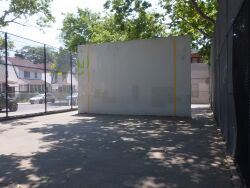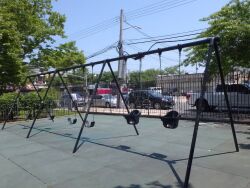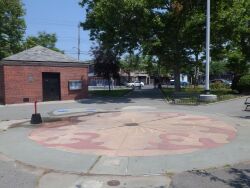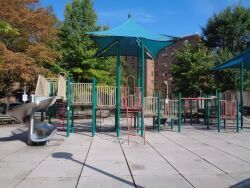Hollis Playground
Hollis Playground
“Hollis” was not developer Frederick W. Denton’s first choice for this neighborhood’s name. He wanted to call it Woodhull, after General Nathaniel Woodhull, who was captured and mortally wounded by the British in 1776, at what is now 197th Street and Jamaica Avenue. However Steuben County already had a Woodhull, so he named this area after his own birthplace in New Hampshire.
General Woodhull was captured at Carpenter’s Tavern, which was built in 1710 and stood until 1921. Woodhull, the Major General of the Militia in Queens and Suffolk during the Revolutionary War (1775-1783), was assigned in 1776 to drive Long Island’s livestock east before it could be stolen by the British, who had recently defeated the patriots during the Battle of Long Island. A thunderstorm forced Woodhull to find shelter in Carpenter’s Tavern, where he was found by British soldiers. Legend has it that he was ordered to say “God save the King!” but refused, instead replying in defiance, “God save us all!” Woodhall is honored by streets named for him in Staten Island, Brooklyn, Queens, and the Bronx, as well as a neighborhood in Steuben County.
After the Revolutionary War, the area remained rural until the late 1880s, when Fredrick Denton, who had been the supervisor of the Town of Jamaica and the Queens Highway Commissioner, acquired 136 acres of land in Hollis and created private lots. Denton provided land for the Hollis station of the Long Island Railroad, which played an important role in the growth of the community. Because the railroad and subways run parallel to each other in Queens, the entire Jamaica-Hollis area developed as a series of longitudinal strips. Commercial development proved to be greatest just north of the railroad, especially on Jamaica Avenue.
In the late 19th and early 20th centuries, the neighborhood expanded with increased trolley service, the development of elegant Victorian houses, the creation of Hollis Park Gardens, and the building of row houses along the streets. Since the end of World War II, the area’s ethnic makeup has diversified, attracting African-Americans and Latin Americans in the 1980s. Today, Hollis is a middle-class neighborhood, home to newcomers from Guyana, Haiti, China, India, and Colombia.
The land for this playground was acquired in 1959 and remains in the jurisdiction of the Board of Estimate, though Parks is responsible for building and maintaining the site. Hollis Playground has been jointly operated with the Board of Education since it opened. This parkland, once known as J.H.S. 192 Playground, named for the adjacent school, also known as Renaissance Middle School, contains a yardarm, two half-basketball courts, four handball courts, and a large play area.
Check out your park's Vital Signs
Clean & Safe
Green & Resilient
Empowered & Engaged Users
Share your feedback or learn more about how this park is part of a
Vital Park System







